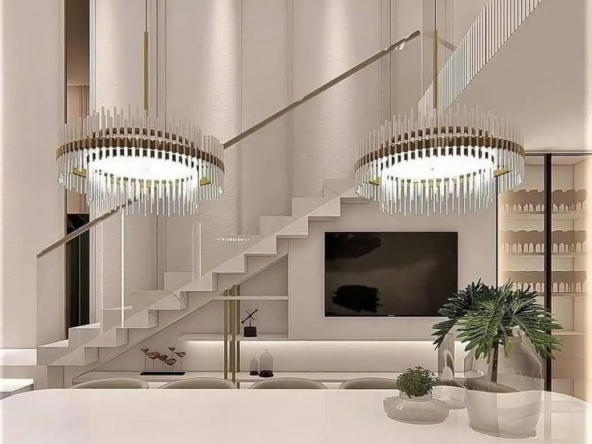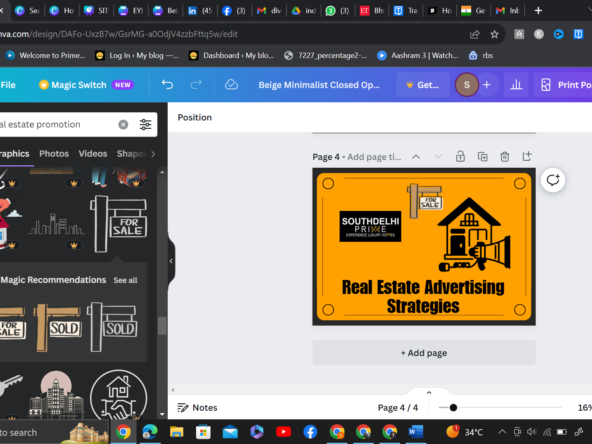The Delhi Building By-Laws refer to the set of regulations and guidelines for the construction, alteration, and maintenance of buildings in the National Capital Territory of Delhi, India. These by-laws are designed to ensure the safety, health, and welfare of the occupants of buildings, as well as the preservation of the environment and the aesthetic values of the city.
They cover various aspects of building construction, including building plans, building height, setbacks, open spaces, fire safety, water supply and drainage, and more. The Delhi Building By-Laws are enforced by the local government, and all buildings in Delhi must comply with these regulations.
In this article, South Delhi Prime will cover everything related to Delhi Building By-Laws in depth. The UBBL Delhi was largely updated in 2016 after a gap of 33 years. There have been a few changes since 2016 and we have covered them all below.
What do the Building By-Laws include?
1. Ground Coverage
2. FAR
3. Setbacks
4. Height
5. General Building Requirements (Balcony, Canopy, Parapet Walls, Boundary Walls, Basement, Stilts, Lifts, Staircase, Lighting & Ventilation)
Ground Coverage
The portion of the building within the outer surface of the structural wall/ column/ slab measured at ground level excluding the projection/ balcony/ canopy/ porch/ void/ shaft permitted free from FAR and cladding/curtain wall up to 150mm shall be considered as ground coverage. In common words, the area of ground you can cover on your plot is called ground coverage.
FAR
For a common man, FAR is the floor area ratio between the floor area and the plot area. How much you could build on your plot in terms of the area considering your plot area and size.
FAR: Te quotient obtained by dividing the total covered area (plinth area) on all floors multiplied by 100 by the area of the plot.
FAR = Total covered area of all floors x 100 / Plot area
For example: On a 251 sqm plot FAR would be 300 hence what you can build will be a total of (251 x 300 )/100 = 753 sqm as a total on all floors. You have a choice to divide it into 4 floors as permitted in Delhi or as you like.
Exclusions
The following shall not be included in the covered area for FAR and Ground coverage calculations.
- Machine room for a lift on the top floor as required for the lift machine installation.
- Rockery, lift/ lift well, escalator/travelator well and well structures, plant nursery, water pool, swimming pool at any level (if uncovered), platform around a tree, tank, fountain, bench, chabutra with open top and/or unenclosed sides by walls, open ramps, compound wall, gate, slide swing door, fire staircase, fire towers, refuse area, fire control room, overhead water tank on top of the building/open shafts, cooling towers as per fire norms. Fire tender movement shall be unhindered.
- Mumty over staircase on top floor maximum 3m height.
- Culvert on Municipal drains.
- Watch and ward cabins of a total area not more than 4.5 sqm and 6 sqm with W.C each at entry and exit only, within the property line. Porta cabins for guard rooms are permitted within the plot line in residential plots of a size minimum of 200 sqm and above.
- Entrance porch, canopies and balconies.
- All pergolas at any floor level not exceeding 20% of Ground Coverage.
- For Residential Plotted development: Balcony to be provided within the plot line to the max width of 1.5 m free from FAR. Wrap-around continuous balconies will be allowed as long as their area does not exceed 40% of the total open area.
- The basement is not to be counted in FAR if used for parking, household storage and services. passageway/corridor constructed more than the prescribed /permissible limit should not be counted towards FAR calculations.
- One toilet on the terrace having a maximum of 2.2 m height shall be permitted subject to the condition that the area of the toilet is a maximum of 4 sq. m and not to be counted in FAR and towards the height of buildings. The total coverage and FAR permissible in any plot in a category, shall not be less than that permissible and available to the largest plot in the next lower category.
- FAR shall be allowed with a maximum size of servant quarter as 25 sq.m and if larger in size would be counted as a full dwelling unit.
- Maximum ground coverage, FAR, and the number of dwelling units for different sizes of residential plots shall be as per the following table:
| S.No | Area of the Plot (Sq Mtr) | Max Ground Coverage % | FAR | No. of DUs | No. of DUs restrained by Supreme Court |
| 1 | Below 32 | 90* | 350 | 3 | 3 |
| 2 | Above 32 to 50 | 90* | 350 | 3 | 3 |
| 3 | Above 50 to 100 | 90* | 350 | 4 | 4 |
| 4 | Above 100 to 250 | 75** | 300* | 4 | 4 |
| 5 | Above 250 to 750 | 75 | 225 | 6 | 5 |
| 6 | Above 750 to 1000 | 50 | 200 | 9 | 7 |
| 7 | Above 1000 to 1500 | 50 | 200 | 9 | 7 |
| 8 | Above 1500 to 2250 | 50 | 200 | 12 | 10 |
| 9 | Above 2250 to 3000 | 50 | 200 | 15 | 10 |
| 10 | Above 3000 to 3750 | 50 | 200 | 18 | 10 |
| 11 | Above 3750 | 50 | 200 | 21 | 10 |
- The total coverage and FAR permissible in any plot in a category, shall not be less than that permissible and available to the largest plot in the next lower category.
- FAR shall be allowed with a maximum size of servant quarter as 25 Sq Mtr and if larger in size would be counted as a full dwelling unit.
SETBACK
The area in your plot on the front rear or sides depending on your plot size, that you leave for light, ventilation and services like connectivity to municipal drains etc is called your plot setback. It is defined as
- An area between the plot boundary and the setback line, the size of which is defined as per the provisions of MPD
- A Strip of land permanently left open for drainage purposes not to be used as an access way and is not a street or be included as a part of setbacks.
Set Back Line: A line usually parallel to the plot boundaries or centre line of a road and laid down in each case by the Authority or as per recommendations of Master/Zonal Plan, beyond which nothing can be constructed towards the plot boundaries, except with the permission of the Authority.
The minimum setbacks in Delhi shall be as given in the following table:
| S. No | Plot Size (Sq Mtr) | Front | Rear | Side 1 | Side 2 |
| 1 | Below 100 | 0 | 0 | 0 | 0 |
| 2 | Above 100 and up to 250 | 3 | 0 | 0 | 0 |
| 3 | Above 250 and up to 500 | 3 | 3 | 3 | 0 |
| 4 | Above 500 and up to 2000 | 6 | 3 | 3 | 3 |
| 5 | Above 2000 and up to 10000 | 9 | 6 | 6 | 6 |
| 6 | Above 10000 | 15 | 9 | 9 | 9 |
In case the permissible coverage is not achieved with the above-mentioned setbacks in a plot, the setbacks of the preceding category may be allowed. Example On a 300 sq yard /251 sqm plot you could choose the setbacks of your preceding category i.e. only leave a front setback of 3 meters if your ground coverage is not being met while taking full FAR for that category.
In the case of a corner plot the road width on which the plot abuts will be considered as the side where the setbacks will be. The higher road width will fetch the setback. In case the road width on both sides is the same the setback will come on the side which has a larger depth.
Height Exemptions
Measurement of Height of a building – The vertical distance in the case of flat roofs is measured from the highest surrounding road level/ ground level up to the top of the structural slab. In case the building does not abut on a street, the height shall be measured from the highest level of the ground immediately adjacent to the building.
The following structures shall not be included in the height of the building in Delhi:
- Roof tanks and their supports not exceeding 1.8 m.
- Ventilating apparatus, air conditioning equipment and lift machine room(s) if required as per the specification of lift manufacturer and similar service equipment.
- Stair covered with Mumtynot exceeding 3 Mtr in height
- Chimneys and parapet walls not exceeding 1.5 Mtr in height
- Screen wall up to the height of 1.5 Mtr
- Solar panel at any height or level (including ground level)//terrace/ rooftop.
- Height of Car lifts/passenger lifts including the machine room accessible to the rooftop/terrace.
- Toilet on the terrace.
- Pergola up to the height of the Mumty, maximum 3m above the terrace of the top floor.
General Building Requirements
- Main Building: The plinth or any part of a building or outhouse shall be so located with respect to the highest surrounding road level from site/ground level irrespective of the location of the entry level so that adequate drainage of the site is assured.
- Interior Courtyards, Covered Parking Spaces and Garages: These shall be satisfactorily drained either by gravity or by mechanical means.
Note: The thickness of outer walls will be maintained at least 230mm
Balcony
Definition:- A horizontal cantilevered/non-cantilevered/projected slab including parapet and handrail balustrade, at any floor level including the terrace to serve as a passage or sit-out place with at least one side fully open, except being provided with railing or parapet wall for safety.
- Balcony within the plot line to the max width of 1.5 m free from FAR.
- Wrap-around continuous balconies will be allowed as long as their area does not exceed 40% of the total open area.
- Minimum double height open terrace shall be permitted measuring @ 10.0 sq.m maximum area with a maximum depth of 3.0m free from FAR.
- End walls up to 0.9 m in terrace-type construction constructed purely as an architectural feature (non-Load Bearing) will be compoundable.
Canopy
In one-storied residential buildings, only such canopy shall be permitted for each individual detached block. In more than one storied residential building, canopies shall be permitted over ground floor entrances with a maximum height of 3 m. from ground level.
A) Front Setback
i) 2.4 m (maximum) deep in case the front setback is 3m deep
ii) 3 m (maximum) deep in case the front setback is 6 m or more.
B) Side setbacks
i) 2.4 m (maximum) deep in case the side setback is 3 m deep.
ii) 3 m (maximum) deep in case the side setback is 6 m. or more.
Note: A minimum of 30% of the area of the respective setback is to be maintained as open to the sky.
Parapet Walls
Parapet: A low wall or railing built along the edge of a roof or a floor; maximum 1.5m for a low-rise or maximum 1.8m for a high-rise.
- Parapet walls and handrails provided on the edges of the roof terrace, balcony etc.
- Minimum 1m Maximum 1.5m
- On the terrace floor in the portion where DG Set, Water Tank and other service equipment are installed, the lightweight screen shall be constructed to hide such equipment
Boundary Walls
- Front Wall- Maximum 1.5m from highest adjacent road level at site/ ground level to be solid (stone/ brick/ masonry etc.) and above 1.5m, it should be perforated(stone jail/iron grills/vegetation)to maintain visual continuity.
- Side & Back Wall – Maximum 2.4 m from ground level to be solid (stone/brick/ masonry etc.)
Basement Rules
Definition:- Basement or Cellar- The lower story of a building below or partly below ground level.
- Minimum clear height 2.4m from beam bottom (soffit) and Minimum width 2.4m.
- Ventilation is a must.
- Adequate arrangements shall be made such that surface drainage does not enter the basement.
- Walls and floors of the basement shall be watertight
- Access to the basement shall be either from the main or alternate staircase providing access to the building. In case a lift is provided in a building (including residential buildings) the same shall also serve the basement area.
- Basements are not to be counted in FAR if used for parking, household storage and services.
- The basement area shall not extend beyond the coverage on the ground floor as per permissible and sanctioned built-up area but may extend to the area below the internal courtyard and shaft.
- Up to 40% of the total setback area can be sunk for light, ventilation and access to the basement, provided fire tender movement is not hindered.
- Sunken courtyard as a ‘light well’ within the building envelope shall be permitted for light and ventilation in the basement area.
- In order to make the basement we need to leave 2 m from the neighbours’ plot. (not mentioned in the bylaws – a separate notification was issued by the LG office)
- One Toilet is permitted within the building envelope in the stilts area and basement subject to appropriate natural/ mechanical ventilation, drainage and sanitation, provided that the maximum size does not exceed 4 sq.m which shall not be counted towards F.A.R.
- One toilet on the terrace having a maximum of 2.2 m height shall be permitted subject to the condition that the area of the toilet is a maximum of 4 sq. m and not to be counted in FAR and towards the height of buildings.
Stilt Parking Rules
Stilt: Stilt or stilt floor means the non-habitable portion of a building above ground level consisting of structural columns supporting the superstructure with at least two sides open for the purpose of parking cars, scooters, cycles and landscaping.
- In case a building is to be constructed on an individual plot with a stilt floor, a minimum of 2.4m height at the soffit level of the beam and a maximum of 2.7m height at soffit level of slab for providing parking space is permitted calculated from the finished floor level.
Note: Stilt is mandatory for plot areas 100 to 1000 Sq Mtr
Lift Rules
- For buildings below 15m the provision of a lift is at the discretion of the owners in order to facilitate the movement of elderly people.
- All the floors including the basement and rooftop/terrace shall be accessible by the lifts. The lifts provided in the buildings shall not be considered as a means of escape in case of emergency.
- For all residential plots size measuring up to 500 sqm and a height below 15 m, the opening of the lift shall be allowed in the staircase landing, provided it does not obstruct movement in general and in emergencies.
- The access to the basement shall be either from the main or alternate staircase providing access to the building. In case a lift is provided in a building (including residential buildings) the same shall also serve the basement area.
Staircase Rules
- Mandatory to provide a ladder or any other form of open access to the overhead tank for inspection e Interior stairs shall be constructed of non-combustible material throughout
- Interior stairs shall be constructed as a self-contained unit and shall be mechanically ventilated if completely enclosed in low-rise residential buildings
- A staircase shall not be arranged around the lift shaft.
- Hollow combustible construction shall not be permitted
- The minimum width of treads without nosing shall be 25 cm for an internal staircase for low-rise residential buildings
- The treads shall be constructed and maintained in a manner to prevents slipping.
- Winders shall be allowed in low-rise residential buildings provided they are not at the head of a downward flight.
- The maximum height of the riser shall be 19 cm in the case of low-rise residential buildings
- The maximum number of risers per flight shall be limited to 15 per flight.
- The maximum height of the riser shall be 150mm in the case of low-rise residential buildings
| Components of Building | Min. Requirement for a dwelling unit above 50 sq.m area |
| Staircases(low rise) | Width 1.0* m |
- Handrails shall be provided with a minimum height of 1.0 m from the centre of the tread subject to the condition that balusters/ railing does not reduce the width of the staircase
- The minimum headroom in a passage under the landing of a staircase and under the staircase shall be 2.2 m
- The lift shall not open on the staircase landing. An adequate Lift Lobby shall be provided. (except for low-rise residential plotted development up to 500 sqm.)
- Clear width excluding handrail and balustrade
- Where staircase discharges through corridors and passageways, the height of corridors and passageways shall be not less than 2.4 m
- All means of exit including staircases, lifts lobbies and corridors shall be naturally/mechanically ventilated.
- The additional area of passageway/ corridor constructed over and above the prescribed /permissible limit, should not be counted towards FAR but shall be counted in Ground Coverage
Lighting & Ventilation of Habitable Rooms
Habitable Room: A room occupied or designed for occupancy by one or more persons for study, living, sleeping, eating and kitchen if it is used as a living room but not including bathrooms, water closet compartments, laundry serving and storage pantries, corridors, cellars, attics and spaces that are not used frequently or during extended periods.
- All habitable rooms shall have for the admission of sun/natural light and air, one or more apertures, such as windows, glazed doors and fan lights, opening directly to the external air or into an open veranda not more than 2.40 m in width.
- In case light and ventilation to habitable space, areas are through an internal courtyard, the minimum dimensions of the such courtyard shall not be less than 3.0 m x 3.0 m for buildings below 15m in height unless mechanically ventilated.
Interiors Open space
- The whole or part of one side of one or more rooms intended for human habitation and not abutting on either the front, rear or side open spaces shall abut on an interior open space whose minimum width in all directions shall be 3.0 m in case of buildings not more than 15 m in height unless mechanically ventilated
- Sunken courtyard as a ‘light well’ within the building envelop shall be permitted for light and ventilation for the basement area.
- Skylight in interior open space(courtyard) may be permitted subject to it may not act as a coverage space on the ground floor and not violate the maximum/ minimum ground coverage
Ventilation Shafts
For ventilating the spaces for water closets and bathrooms, if not opening on the front side, rear and interior open spaces, shall open on the ventilation shaft, the size of which shall not be less than the values given below.
The roof of the shaft shall be 1m above the surrounding roof.
| Height of Building in m | Size of ventilation shaft in Sq Mtr | Minimum Size of the shaft in m |
| Upto 9.0m | 1.5 | 1.0 |
| Above 9.0 m and below 15.0 m | 3.0 | 1.2 |
However, it is not mandatory in the case of buildings where mechanical ventilation is provided.
Important Note: All rooms like the kitchen & bathrooms can also be mechanically ventilated through an exhaust opening in an interior or exterior open space.
A typical shaft in a 4-storeyed building of height just less than 15 m is 3 sqm and 1.2 m. Interior open-to-sky areas shall be allowed to cover with retractable roofing at the terrace level or at a minimum double height to prevent climatic/weathering effects and the space below can be used as landscaped area, public space but cannot be used for any commercial purpose.
We hope that this article was informative and helpful in understanding the Delhi Building By-Laws. It is important for individuals involved in construction and real estate in Delhi to be aware of these regulations and to ensure compliance with them. The by-laws play an important role in ensuring the safety and well-being of building occupants and the preservation of the environment and aesthetic values of the city.









